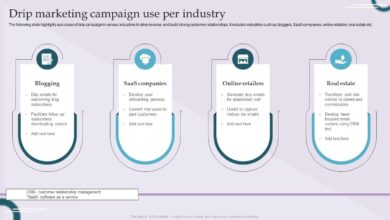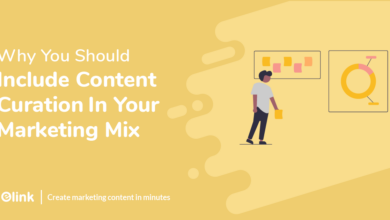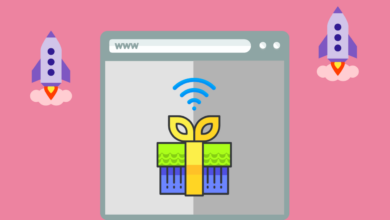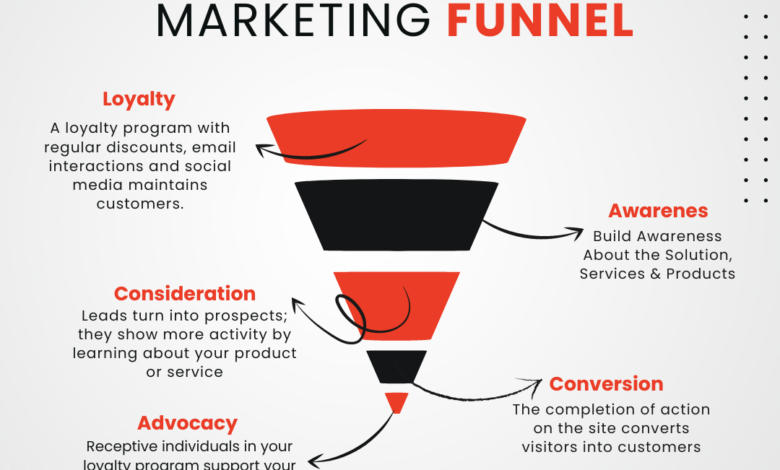
What is the Marketing Funnel A Deep Dive
What is the marketing funnel? It’s a powerful framework that guides potential customers through a structured journey, from initial awareness to final purchase. This comprehensive guide delves into the intricacies of the marketing funnel, exploring its stages, metrics, content strategies, and optimization techniques. Understanding this crucial element of modern marketing is key to driving growth and achieving business objectives.
This exploration will unravel the different types of funnels, examining their strengths and weaknesses. We’ll analyze how to tailor messaging and content for each stage, ensuring maximum engagement and conversion. We’ll also touch on how to create customer journey maps that align with the marketing funnel, leading to a seamless and satisfying experience for your customers.
Defining the Marketing Funnel
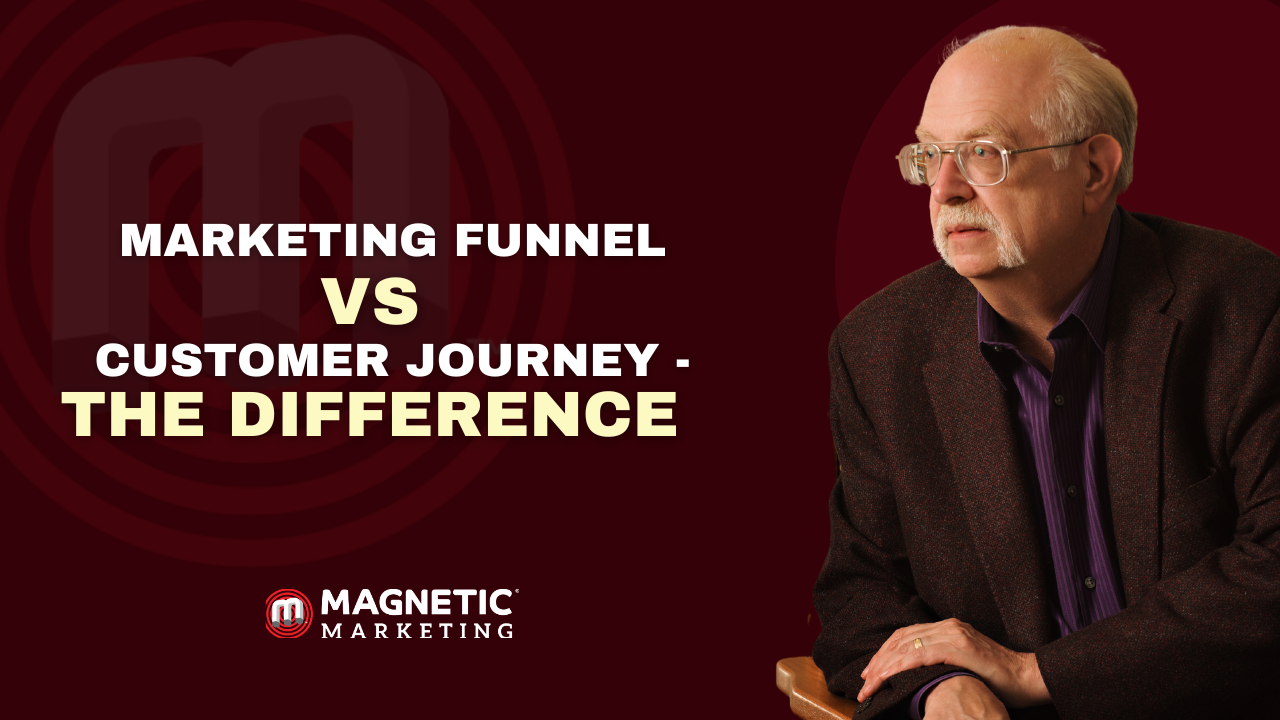
The marketing funnel, a cornerstone of modern marketing strategies, visually represents the customer journey from initial awareness to eventual purchase. Understanding its stages and nuances allows businesses to tailor their efforts to effectively guide prospects through the process, maximizing conversions. This framework is crucial for aligning marketing campaigns with customer needs and behaviors, ensuring resources are allocated strategically.The marketing funnel isn’t just a theoretical concept; it’s a practical tool for measuring and optimizing marketing performance.
Understanding the marketing funnel is key to any successful campaign. It’s essentially the journey a potential customer takes from initial awareness to purchase. Knowing how your Instagram audience interacts with your stories is crucial to fine-tuning this funnel. For example, checking out Instagram Stories analytics, like impressions, reach, and engagement rates, gives you a real-time snapshot of where your audience is in this journey.
Instagram Stories analytics every metric you need to know will help you understand the data behind these metrics and how to use them to optimize your content and improve conversion rates within the funnel. Ultimately, a strong understanding of your customer journey and the metrics that track it are the foundation of a successful marketing strategy.
By tracking progress through each stage, businesses can identify bottlenecks and adjust their strategies to improve conversion rates. This process allows for a more data-driven approach to marketing, leading to better ROI and more informed decision-making.
Defining the Marketing Funnel Stages
The marketing funnel typically consists of four key stages: awareness, consideration, decision, and action. Each stage represents a distinct phase in a potential customer’s journey towards becoming a paying customer. These stages are interconnected and build upon each other.
Awareness
This initial stage focuses on making potential customers aware of your product or service. It’s about creating visibility and building brand recognition. Examples include social media posts, blog articles, search engine optimization (), and paid advertising. The goal is to generate interest and curiosity about your offerings.
Consideration
Prospects in the consideration stage are actively researching and comparing your product or service to alternatives. They’re evaluating features, benefits, and pricing. At this point, content marketing plays a vital role. Examples include in-depth blog posts, product demos, case studies, and testimonials. Your aim is to build trust and demonstrate expertise.
Decision
At the decision stage, prospects are nearing a purchase. They’re likely comparing your product to direct competitors and considering the final details. Examples of actions include providing clear calls-to-action (CTAs), offering limited-time promotions, or showcasing customer reviews. The focus here is on providing compelling reasons to choose your product over the competition.
Action
The final stage involves the actual purchase. This stage requires seamless and efficient processes. Examples include a user-friendly website, secure payment gateways, and excellent customer service. The goal is to make the buying experience as smooth as possible, ensuring customer satisfaction.
Types of Marketing Funnels
Various types of marketing funnels cater to different business needs and customer behaviors. A key consideration is tailoring the funnel to the specific customer journey for your product or service.
Relationship Between Funnel Stages
The relationship between awareness, consideration, decision, and action is a sequential process. A prospect progresses through these stages, moving from initial awareness to a final purchase decision. Each stage builds upon the previous one, nurturing the prospect towards conversion.
Marketing Funnel Stages Table
| Stage | Description | Example Actions |
|---|---|---|
| Awareness | Creating brand visibility and generating initial interest. | Social media campaigns, content marketing, , paid advertising. |
| Consideration | Educating potential customers about your product and its benefits. | In-depth blog posts, product demos, case studies, testimonials. |
| Decision | Nurturing prospects toward a purchase decision. | Clear calls-to-action, limited-time promotions, customer reviews. |
| Action | Facilitating the purchase process and ensuring customer satisfaction. | User-friendly website, secure payment gateways, excellent customer service. |
Stages of the Marketing Funnel
The marketing funnel, a crucial framework for understanding customer journeys, breaks down the process of attracting, engaging, and converting leads into paying customers. Each stage represents a different level of customer interaction and requires a tailored approach. Understanding these stages allows marketers to optimize their efforts and maximize their return on investment.
Awareness Stage
This initial stage focuses on making potential customers aware of your brand and products or services. It’s about building brand recognition and establishing a presence in the market. Marketers often make the mistake of jumping straight into selling, neglecting the importance of building a relationship and establishing trust. Effective awareness-building strategies include content marketing, social media engagement, and search engine optimization ().
- Characteristics: Potential customers are unfamiliar with your brand or product. They are searching for solutions to their problems, and your brand needs to be top of mind.
- Common Mistakes: Focusing solely on sales pitches instead of valuable information. Not creating engaging content that resonates with the target audience. Failing to leverage the power of social media.
- Content Examples: Blog posts, articles, social media updates, infographics, and educational videos about industry trends.
Consideration Stage
Potential customers now have a better understanding of your brand and are actively researching options. This stage is crucial for demonstrating value and building credibility. Marketers often fall short by not providing enough comparative information, failing to differentiate their offerings, and not nurturing leads effectively.
- Characteristics: Potential customers are actively evaluating their options. They’re comparing your brand with competitors and looking for proof of value.
- Common Mistakes: Not highlighting the unique selling propositions (USPs) of your product. Failing to provide in-depth information on how your product addresses their needs. Not actively engaging with potential customers through various channels.
- Content Examples: Case studies, product demos, webinars, comparisons with competitors, and testimonials from satisfied customers.
Decision Stage
At this stage, potential customers are nearing a purchasing decision. They’re weighing the pros and cons of different options. Marketers need to reinforce the value proposition and address any remaining doubts. Common pitfalls include failing to clearly articulate the next steps, not providing enough support, and not being proactive in answering questions.
- Characteristics: Potential customers are actively comparing and deciding between products and services. They are looking for concrete evidence of value and clear next steps.
- Common Mistakes: Not making it easy for customers to take the next step in the buying process. Not providing sufficient support and resources. Not addressing customer objections effectively.
- Content Examples: Detailed product descriptions, FAQs, financial calculators, personalized recommendations, and interactive tools.
Action Stage
This is the final stage where the potential customer makes the purchase. A key focus here is on making the process smooth and easy. Marketers often fail to streamline the purchase process, resulting in lost conversions. Clear call-to-actions (CTAs) and excellent customer service are vital.
- Characteristics: The potential customer has made a purchase decision. They’re ready to complete the transaction.
- Common Mistakes: Complex or lengthy checkout processes. Lack of clear call-to-actions. Poor customer service that hinders the buying experience.
- Content Examples: Order forms, payment gateways, delivery options, and thank-you pages.
Comparing Marketing Funnel Stages
| Stage | Characteristics | Common Mistakes | Appropriate Content |
|---|---|---|---|
| Awareness | Building brand recognition | Overselling, lack of engaging content | Blog posts, social media updates |
| Consideration | Evaluating options | Lack of USPs, insufficient comparison | Case studies, product demos |
| Decision | Weighing pros & cons | Complex processes, unanswered questions | Detailed product descriptions, FAQs |
| Action | Making a purchase | Complex checkout, poor service | Order forms, payment gateways |
Tailoring Messaging for Each Stage
Tailoring your messaging to each stage of the marketing funnel is essential for effective communication. For example, in the awareness stage, focus on educating potential customers about your industry. In the decision stage, highlight the unique benefits of your product compared to competitors. This personalized approach increases engagement and conversion rates.
Key Metrics and KPIs: What Is The Marketing Funnel
Understanding the performance of your marketing funnel is crucial for optimization. Knowing which metrics to track and how to interpret them is key to achieving your marketing goals. This section delves into the vital metrics and key performance indicators (KPIs) that provide insights into each stage of the funnel, allowing you to fine-tune your strategies for maximum impact.Tracking these metrics allows for a data-driven approach to marketing.
By monitoring key performance indicators, you can identify areas of strength and weakness within your campaigns. This data-driven approach empowers you to make informed decisions, allocate resources effectively, and ultimately improve the overall performance of your marketing initiatives.
Key Metrics for Measuring Funnel Performance
Understanding the different metrics for each stage of the marketing funnel allows for a more comprehensive analysis of its effectiveness. This detailed approach helps pinpoint areas requiring improvement and allows for strategic adjustments. Crucially, these metrics provide insights into the efficiency of each stage, enabling informed decisions and ultimately leading to better results.
Metrics for Awareness Stage
The awareness stage focuses on generating initial interest and visibility for your brand. Metrics here evaluate how effectively your brand is reaching potential customers. Key metrics include website traffic, social media engagement, and brand mentions.
- Website Traffic: This measures the number of visitors to your website. Analyzing the sources of this traffic (e.g., organic search, social media, paid advertising) provides insight into which channels are most effective at driving awareness. A significant increase in traffic might signal a successful marketing campaign, while a decline might indicate the need for adjustments.
- Social Media Engagement: This metric considers likes, shares, comments, and follower growth on your social media platforms. High engagement indicates a strong connection with your target audience. Analyzing which posts perform best reveals what resonates with your audience.
- Brand Mentions: Tracking how often your brand is mentioned in online conversations, social media, or news articles provides a broader picture of your brand’s visibility. Positive mentions indicate successful brand building. Negative mentions require investigation and addressing potential issues.
Metrics for Interest Stage
The interest stage aims to capture the attention of potential customers who have shown initial interest in your brand. Metrics here measure engagement and interaction.
- Landing Page Conversions: This metric measures the number of visitors who complete a desired action on your landing page, such as filling out a form or requesting a demo. High conversion rates indicate that your landing pages effectively capture leads. Low conversion rates suggest improvements are needed in page design, messaging, or call to action.
- Click-Through Rate (CTR): CTR measures the percentage of people who click on a link, ad, or call to action. High CTRs suggest compelling content and effective ad copy. Low CTRs might indicate a need for better ad targeting or more persuasive messaging.
Metrics for Decision Stage
The decision stage is where potential customers evaluate your product or service against competitors. Metrics here assess the level of engagement and confidence.
- Lead Qualification Rate: This metric measures the percentage of leads that qualify as sales-ready prospects. A high qualification rate indicates an effective lead generation strategy. Low qualification rates suggest refining your lead generation tactics or nurturing your leads more effectively.
- Customer Lifetime Value (CLTV): This metric projects the total revenue a customer is expected to generate throughout their relationship with your company. Analyzing CLTV is essential for understanding the profitability of different customer segments.
Metrics for Action Stage
The action stage is where potential customers make a purchase or take a desired action. Metrics here focus on conversion and customer retention.
- Conversion Rate: This metric represents the percentage of visitors who complete a desired action, such as making a purchase. High conversion rates indicate a successful sales process. Low conversion rates signal potential problems in the checkout process, pricing, or overall sales experience.
- Customer Acquisition Cost (CAC): CAC represents the total cost of acquiring a new customer. Analyzing CAC in relation to CLTV provides valuable insight into the profitability of your marketing campaigns.
Summary Table
| Stage | Metric | Relevance |
|---|---|---|
| Awareness | Website Traffic, Social Media Engagement, Brand Mentions | Measures initial brand visibility and audience interaction |
| Interest | Landing Page Conversions, Click-Through Rate | Assesses engagement and interest in your offerings |
| Decision | Lead Qualification Rate, Customer Lifetime Value | Evaluates lead quality and long-term customer value |
| Action | Conversion Rate, Customer Acquisition Cost | Measures final conversion and cost of acquiring customers |
Content Strategy for Each Stage

Crafting a compelling content strategy is crucial for navigating the marketing funnel effectively. It’s not enough to simply produce content; it must resonate with your audience at each stage of their journey, from initial awareness to final conversion. This tailored approach ensures your message is relevant and persuasive, maximizing the impact of your efforts.A well-defined content strategy adapts to the evolving needs and expectations of your target audience as they progress through the funnel.
This necessitates a shift in focus from broad awareness campaigns to highly specific, targeted messaging as users move closer to conversion. Understanding the nuances of each stage allows for a more impactful and engaging experience.
Awareness Stage Content
Content at this stage focuses on building brand awareness and establishing credibility. The goal is to introduce your brand and value proposition to potential customers who may not yet be aware of your products or services. This stage is often about educating and informing, fostering curiosity and interest.
- Blog posts featuring industry insights, thought leadership articles, and educational guides are ideal for establishing expertise and attracting potential customers.
- Social media updates should highlight your brand’s personality and values, sharing engaging content like infographics, videos, and interactive polls to capture attention and increase visibility.
- Free resources such as ebooks, webinars, or templates can entice visitors to learn more about your offerings and your industry.
Using storytelling is essential to capture attention and create an emotional connection with your audience. Sharing compelling narratives that illustrate your brand’s mission and values can help build a strong brand identity. Engagement at this stage involves fostering conversations and encouraging interaction.
Consideration Stage Content
At this point, potential customers are actively researching and evaluating their options. Content here needs to provide more detailed information and address specific needs and concerns. This stage emphasizes comparison and evaluation.
- Case studies showcase successful implementations of your products or services, offering proof points and addressing potential concerns.
- Comparison articles that objectively analyze your offerings against competitors can demonstrate your value proposition and guide decision-making.
- Product demos and tutorials help users understand how your products or services work, fostering a deeper understanding of their features and benefits.
Tailored content is critical at this stage, as users are actively seeking solutions to their problems. Engaging content formats, such as interactive quizzes, calculators, and videos, can help users visualize the solutions and understand how your product or service can help them.
Understanding the marketing funnel is key to any successful business strategy. It’s essentially a visual representation of the customer journey, from initial awareness to eventual conversion. For photographers looking to maximize their reach and engagement, platforms like Instagram are crucial. Using Instagram effectively, as detailed in this helpful guide instagram for photographers showcase your visual artistry , can significantly improve your brand visibility and connect with potential clients.
This visual storytelling approach fits perfectly within the top stages of the marketing funnel, helping to nurture leads and build a strong customer base.
Decision Stage Content
Here, customers are ready to make a purchase decision. Content needs to be highly persuasive and focused on addressing specific concerns and justifying the investment.
- Testimonials and reviews provide social proof, demonstrating the value of your product or service to potential customers.
- Detailed product pages with high-quality images and comprehensive descriptions, highlighting key features and benefits, are crucial.
- Limited-time offers and discounts can incentivize purchases, creating a sense of urgency and value.
Storytelling in this stage can emphasize the personal impact of your product or service. Highlighting how your product or service has positively impacted others can build trust and encourage conversion.
Action Stage Content, What is the marketing funnel
This is where the purchase is made, and the goal is to maintain engagement and encourage repeat business.
- Order confirmation emails should provide clear instructions and highlight next steps, building anticipation for delivery and usage.
- Post-purchase surveys gather feedback and identify areas for improvement, leading to enhanced customer satisfaction.
- Loyalty programs and exclusive content incentivize repeat purchases and cultivate long-term customer relationships.
Content at this stage should reinforce the value proposition and emphasize the customer’s satisfaction.
| Stage | Content Type | Example Content |
|---|---|---|
| Awareness | Blog Posts | “5 Ways to Improve Your Productivity” |
| Awareness | Social Media | Infographic on a relevant industry topic |
| Consideration | Case Studies | “Client X Achieved 20% Increase in Sales Using Our Platform” |
| Decision | Product Pages | Detailed description of a specific product, including features, benefits, and FAQs |
| Action | Order Confirmation | Clear instructions on tracking the order and managing the account |
Customer Journey Mapping
Understanding the customer’s entire experience, from initial awareness to post-purchase engagement, is crucial for effective marketing. Customer journey mapping provides a visual representation of this experience, allowing businesses to identify pain points, optimize interactions, and ultimately drive customer satisfaction and loyalty. It directly connects to the marketing funnel, highlighting how different stages influence the customer’s journey.Customer journey mapping is not just a visualization; it’s a powerful tool for aligning marketing efforts with customer needs.
By understanding the customer’s emotional and rational responses at each touchpoint, businesses can create more personalized and effective marketing strategies. This leads to improved conversion rates, stronger customer relationships, and increased profitability.
Relationship to the Marketing Funnel
The marketing funnel represents the stages a customer goes through before making a purchase. Customer journey mapping extends this understanding by detailing the customer’s experience at each touchpoint within those stages. It provides a richer, more nuanced view of the customer’s actions and motivations, going beyond simple funnel stages to include the emotions and context surrounding each interaction.
By combining the funnel’s stages with the journey map, businesses gain a holistic picture of the customer’s experience.
Steps in Creating a Customer Journey Map
Creating a comprehensive customer journey map involves several key steps. First, define your target customer persona, outlining their demographics, needs, motivations, and pain points. Second, identify the key touchpoints in the customer’s journey, from initial awareness to post-purchase support. These include website visits, social media interactions, email communications, and in-store experiences. Third, map the customer’s experience at each touchpoint, considering their emotions, thoughts, and actions.
Fourth, identify pain points and opportunities for improvement. Finally, develop strategies to enhance the customer experience at each stage.
Importance of Customer Experience at Each Stage
Customer experience is paramount at every stage of the marketing funnel. In the awareness stage, a positive experience might involve finding valuable, engaging content that positions the company as a solution to a problem. In the consideration stage, a positive experience could involve clear, informative product information and user-friendly navigation. During the decision stage, ease of purchase and trust-building elements are critical.
Finally, in the loyalty stage, a positive experience could include excellent post-purchase support and opportunities for ongoing engagement.
Visual Representation of the Customer Journey
A visual representation of the customer journey can be a simple flow chart or a more complex diagram, such as a timeline or a multi-stage process map. The specific representation depends on the complexity of the customer journey and the insights you want to communicate. This visual depiction allows teams across departments to see the complete customer experience.
Example: Customer Journey Map Integrated with a Marketing Funnel
Imagine a company selling high-end gardening tools. Their marketing funnel focuses on stages: awareness, consideration, decision, and action. Their customer journey map would detail the customer’s experience at each touchpoint within those stages. For instance, in the awareness stage, the customer might discover the company through an engaging social media post showcasing a beautiful garden. This leads them to the company website, where they learn more about the tools and their benefits, representing the consideration stage.
The marketing funnel, essentially, is a visual representation of the customer journey. It shows how potential customers move through different stages, from awareness to conversion. A crucial part of optimizing this journey, especially for a mobile audience, is optimizing for mobile subdomain SEO. This approach ensures your website is easily accessible and performs well on mobile devices, impacting your overall marketing funnel effectiveness.
Think of it as ensuring a smooth, user-friendly path down the funnel. Knowing how to implement mobile subdomain SEO is a key step in understanding and improving the overall marketing funnel process for your business.
The decision stage might involve comparing the company’s tools with competitors through online reviews and product comparisons. The final action involves purchasing the tool and receiving excellent customer service after the sale, leading to customer loyalty.
Optimizing the Marketing Funnel
Fine-tuning your marketing funnel is crucial for maximizing your return on investment (ROI). It’s not just about getting more leads; it’s about attracting the right leads who are more likely to convert into paying customers. Effective optimization involves understanding the behavior of your target audience at each stage of the process and tailoring your strategies accordingly.
Strategies for Optimizing Each Stage
Optimizing each stage of the funnel involves a multifaceted approach that considers the specific needs and pain points of your target audience at each juncture. Understanding the customer journey is paramount, and this necessitates detailed analysis of user behavior and interaction with your marketing messages.
- Top of the Funnel (TOFU): Attracting initial awareness and interest. This stage often involves content marketing, social media campaigns, and search engine optimization (). Optimize TOFU by creating highly engaging content that resonates with your target audience’s needs and interests. This might include blog posts, infographics, or videos demonstrating expertise and addressing common questions.
- Middle of the Funnel (MOFU): Nurturing leads and educating them about your product or service. Here, personalized content tailored to individual needs is key. Optimize MOFU by offering free resources like ebooks, webinars, or templates that provide value and position your company as a trusted advisor. Consider using lead magnets, strategically placed calls to action, and email marketing to nurture leads.
- Bottom of the Funnel (BOFU): Converting leads into paying customers. This stage requires a persuasive sales pitch and clear call-to-action (CTA) strategy. Optimize BOFU by presenting a compelling value proposition, highlighting the unique benefits of your product or service, and streamlining the purchase process. Offer different payment options and provide comprehensive support materials to alleviate customer anxieties.
Improving Conversion Rates at Each Stage
Improving conversion rates involves a data-driven approach that focuses on identifying bottlenecks and optimizing each step of the customer journey. This requires an understanding of customer behavior, pain points, and motivations. The goal is to create a seamless and user-friendly experience that encourages conversions.
- TOFU: Increase click-through rates (CTR) by creating compelling headlines and visuals. Implement A/B testing to optimize calls-to-action (CTAs) and landing page design. Track and analyze which marketing channels are driving the most qualified leads.
- MOFU: Enhance lead nurturing by segmenting your audience and personalizing communications. Increase email open rates by optimizing subject lines and crafting relevant content. Use interactive elements like quizzes and polls to engage leads and collect valuable data.
- BOFU: Reduce friction in the purchase process by simplifying forms and providing multiple payment options. Use persuasive language and testimonials to build trust and encourage purchases. Offer a strong customer support system to address any questions or concerns post-purchase.
The Role of A/B Testing in Funnel Optimization
A/B testing is a crucial tool for optimizing your marketing funnel. It involves comparing two versions of a webpage, email, or ad to determine which performs better. By iteratively testing different variations, you can identify what resonates best with your target audience and optimize conversion rates.
- A/B testing helps identify the most effective headlines, calls-to-action, and visuals. This data-driven approach is essential for continuous improvement.
- Testing different landing pages, email templates, and ad copy can significantly improve conversion rates. Tracking key metrics, like click-through rates and conversion rates, is paramount to identifying areas for optimization.
- The success of A/B testing relies on clear hypotheses, well-defined metrics, and consistent tracking. Use tools like Google Optimize or Optimizely to effectively manage your A/B testing campaigns.
Examples of Successful Funnel Optimization Strategies
Successful optimization strategies often involve a combination of tactics. Companies that have effectively optimized their funnels often prioritize understanding their customer journey, segmenting their audience, and tailoring their messaging to specific needs.
- Example 1: A software company used A/B testing to optimize their landing page, resulting in a 25% increase in lead generation. They tested different headlines, calls-to-action, and visuals to determine which resonated best with their target audience.
- Example 2: An e-commerce store improved its conversion rate by 15% through personalized email marketing campaigns. They segmented their customers based on past purchase history and product preferences, tailoring their messaging to individual needs and interests.
Optimization Tactics and Potential Impact
This table illustrates various optimization tactics and their potential impact on conversion rates.
| Optimization Tactic | Potential Impact |
|---|---|
| Improved landing page design | Increased conversion rates by 10-20% |
| Personalized email marketing | Increased open rates and conversion rates by 15-25% |
| Streamlined checkout process | Reduced cart abandonment and increased conversions by 5-10% |
| Stronger calls-to-action (CTAs) | Increased click-through rates and conversions by 10-15% |
Examples of Marketing Funnels in Action
Marketing funnels aren’t just theoretical constructs; they’re powerful tools used by businesses across various industries to attract, engage, and convert customers. Understanding how these funnels operate in practice provides valuable insights into effective strategies and helps tailor approaches for specific needs. Successful implementations often leverage the stages of the funnel, integrating diverse marketing channels to drive engagement and conversions.
Real-world examples demonstrate the adaptability and effectiveness of the marketing funnel. By analyzing how different businesses have implemented successful funnels, we can identify key strategies, common challenges, and innovative solutions.
E-commerce Funnel Example: An Online Bookstore
Consider an online bookstore targeting book lovers. Their funnel might start with attracting potential customers through social media ads showcasing new releases and author interviews. The middle stage involves nurturing leads with email newsletters featuring book recommendations tailored to their past purchases or browsing history. This fosters engagement and creates a sense of community. Finally, the conversion stage might offer exclusive discounts or bundles for returning customers or early adopters of new book series.
Software as a Service (SaaS) Funnel Example: Project Management Tool
A SaaS company offering a project management tool might use content marketing, like blog posts and webinars on project management best practices, to attract potential users. They’d then offer free trials or demos to encourage engagement and experience the tool’s features. Finally, they could implement upselling strategies by suggesting premium features or additional team licenses to existing customers, based on usage data and patterns.
Travel Agency Funnel Example: Luxury Vacation Packages
A travel agency specializing in luxury vacation packages might utilize targeted advertising on platforms frequented by high-net-worth individuals, like exclusive social media groups and luxury lifestyle publications. This attracts the ideal customer profile. Further engagement might involve personalized consultations via email or phone, showcasing detailed itineraries and customized options. Conversion involves finalizing booking details and ensuring exceptional customer service throughout the entire journey.
Challenges and Opportunities Across Industries
Each industry presents unique challenges and opportunities. E-commerce faces competition from numerous online retailers, requiring strategic pricing and personalized offers. SaaS companies need to demonstrate value propositions to potential customers and showcase the ROI of their software. Travel agencies must manage fluctuating pricing, secure booking slots, and maintain exceptional service throughout the customer journey.
Integrated Marketing Channels within a Funnel
Successful funnels integrate various marketing channels. For example, a travel agency might use social media for brand awareness and initial customer engagement. They could leverage email marketing for targeted promotions and customer relationship management. Paid advertising might help reach a wider audience. The key is to ensure that each channel works seamlessly to support the overall funnel objectives.
Table of Marketing Funnel Examples
| Funnel Example | Industry | Key Strategies |
|---|---|---|
| Online Bookstore | E-commerce | Social media marketing, email newsletters, exclusive discounts |
| Project Management Tool | SaaS | Content marketing, free trials, upselling |
| Luxury Vacation Packages | Travel | Targeted advertising, personalized consultations, exceptional service |
Different Types of Marketing Funnels
The marketing funnel isn’t a one-size-fits-all solution. Different businesses and marketing objectives require tailored approaches. Understanding the various types of funnels empowers marketers to choose the strategy that best aligns with their goals and target audience. This section delves into the different funnel models, highlighting their characteristics, applications, advantages, and disadvantages.
Inbound Marketing Funnel
Inbound marketing funnels attract customers through valuable content and experiences. Instead of interrupting potential customers, inbound funnels aim to draw them in by providing relevant information and solutions. This approach focuses on building relationships and establishing trust.
- Focus: Attract, engage, and delight customers with valuable content.
- Characteristics: Emphasizes organic reach, content marketing, , social media engagement, and building a community.
- Advantages: Builds trust, fosters long-term relationships, generates high-quality leads, and often results in lower customer acquisition costs.
- Disadvantages: Requires a long-term commitment to content creation and can take longer to see results than outbound strategies.
- Examples: HubSpot, Neil Patel, and many SaaS companies leverage inbound funnels to attract customers through blogs, webinars, and helpful resources.
Outbound Marketing Funnel
Outbound marketing funnels actively seek out potential customers. This approach typically involves paid advertising, direct mail, cold calling, and other forms of direct outreach.
- Focus: Reaching a broad audience through various paid promotion channels.
- Characteristics: Aggressive approach to reaching prospects, often using targeted ads, paid social media campaigns, and email marketing.
- Advantages: Can reach a large audience quickly, ideal for immediate brand awareness campaigns, and can generate quick results.
- Disadvantages: Can be perceived as intrusive, potentially leading to lower conversion rates if not well-targeted, and can have higher customer acquisition costs.
- Examples: Companies like telemarketing firms, direct response advertisers, and many product-focused retail businesses frequently use outbound marketing methods.
Multi-Stage Marketing Funnel
Multi-stage funnels combine elements of both inbound and outbound strategies. This approach recognizes that different customers respond to different stimuli and requires a more nuanced approach.
- Focus: A hybrid approach leveraging both inbound and outbound methods for maximum impact.
- Characteristics: Often uses a combination of content marketing, , social media, paid advertising, and email marketing. It prioritizes customer journey mapping and adapting the approach for different stages of the funnel.
- Advantages: Broader reach and greater potential for lead generation than single-strategy approaches, offers more flexibility to adjust strategy based on performance, and creates a more engaging customer experience.
- Disadvantages: Requires significant planning and coordination between different marketing channels, may need more resources and time to manage, and potentially more complex to measure and optimize.
- Examples: E-commerce businesses often utilize a multi-stage approach by combining paid ads for initial brand awareness with for long-term traffic and email marketing for nurturing leads.
Comparison Table
| Characteristic | Inbound | Outbound | Multi-Stage |
|---|---|---|---|
| Focus | Attracting customers | Reaching customers | Combining attraction and outreach |
| Content | Valuable, informative | Persuasive, promotional | Varied, tailored to stage |
| Cost | Potentially lower long-term | Potentially higher upfront | Variable, depends on mix |
| Time to results | Longer-term | Faster results | Moderate to long-term |
| Customer interaction | Active engagement | Passive engagement | Active and passive engagement |
Summary
In conclusion, mastering the marketing funnel is essential for any business aiming to achieve sustainable growth. By understanding the different stages, optimizing for each one, and adapting to changing customer behaviors, businesses can transform their marketing efforts into a high-performing machine. This guide has provided a solid foundation, equipping you with the knowledge and tools to build a compelling and effective marketing funnel that resonates with your target audience.
